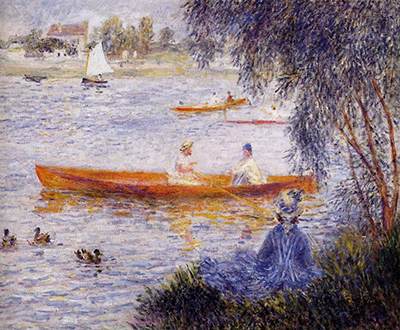Although Renoir painted a number of boating scenes, especially between 1879 and 1880, this example was completed in 1883.
Like his impressionist counterpart and mentor Monet, Renoir often chose to paint similar subjects. Similar in content to The Seine At Asnieres (The Skiff) the painting features the river Seine, but this time at the commune of Argenteul.
As with so many impressionist paintings, the vibrancy of the colouration leaps out from the canvas. The subtle play of light and shade; the lightness of touch and the sheer intensity and integrity of all the various components reward your gaze. Claude Monet similarly captured Sailing Boat in Argenteuil, The Studio Boat, Cliffs and Sailboats at Pourville and Sailboat.
The colours are more subtle in this work compared to other paintings by Renoir, but shades and tones interact with with powerful effect and the use of soft and sharp focus grabs the attention.
The main feature is the couple in the boat, the shades of orange, yellow, and purple contrasting with their white clothing.
From here, one is tempted to look away to the boat higher up in the picture with its complimentary colours but the cascading tree branches to the right draw you away. Although an impressionist work, the detail in the painting of the tree is very distinctive even to the leaf shapes on the drooping branches.
The purple and mauve foliage compliment the generally blue tone of the entire painting particularly in the ripples on the surface of the water. Colour and form are cleverly linked.
Next, we follow the hanging branches to the seated, smartly dressed figure on the river's bank whose dress folds, like the tree's branches, cascade down towards to the ground spreading around her.
Finally, we come to the darker area below with its thick crop of vegetation interspersed with dashes and shades of yellow and green. One of the key elements in the impressionist approach to art was to create luminosity.
This was achieved by working from dark to light colours as well as using short brush strokes. It was also the practice to build up layers of colour and to set contrasting colours next to one another, but without actually blending them together. In this way, the viewer could use their own level of perception to appreciate the various desired effects the artist was attempting to achieve.
Renoir used what was termed a "rainbow palette" which consisted of seven colours plus the colour white. This is widely used in the painting although the effect is muted slightly with the addition of possibly a touch of red to give a pinkish tinge perhaps to suggest the sun's glow on the water.
Impressionism was all about reacting with immediacy to what was occurring and it's possible that Renoir waited until all the right elements coalesced for his snapshot moment.
Moving towards the top of the scene, the colouration is less intense, but looking over the river and across to the opposite bank we can get a sense of scale.
Overall, the painting is colourful, structured with contours and lines that draw you in as an observer. And a combination of subtle tones and textures that bring the scene completely to life.




